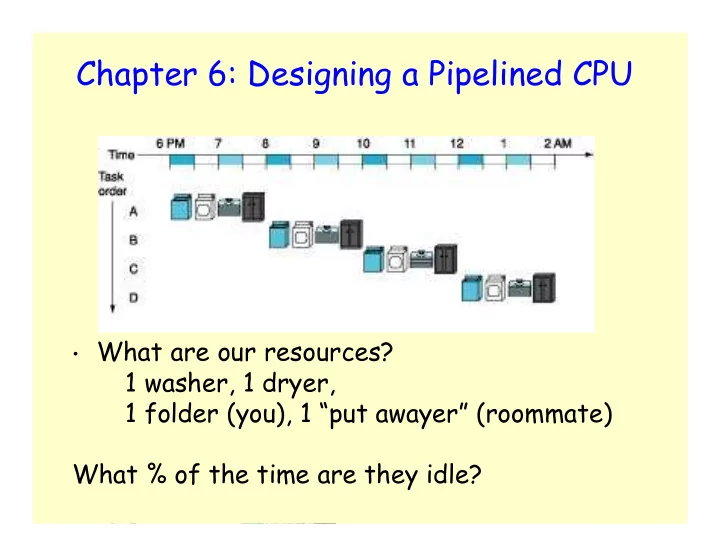

Chapter 6: Designing a Pipelined CPU • What are our resources? 1 washer, 1 dryer, 1 folder (you), 1 “put awayer” (roommate) What % of the time are they idle? 1
2 Chapter 6: Designing a Pipelined CPU
Chapter 6: Designing a Pipelined CPU What % of the time are resources idle? - steady-state - ramp up - ramp down 3
Chapter 6: Designing a Pipelined CPU What is our roommate takes off? What happens to the pipeline? 4
Chapter 6: Designing a Pipelined CPU Massive Laundry Pile What if our roommate is gone? What happens to the pipeline? 5
Chapter 6: Designing a Pipelined CPU Massive Laundry Pile What if our roommate is gone? What happens to the pipeline? 6
Chapter 6: Designing a Pipelined CPU No Laundry Pile Scheduling work later reduces “laundry pile” 7
Chapter 6: Designing a Pipelined CPU Scheduling work later reduces “laundry pile” 8
Execution in a Pipelined Datapath TIME CC1 CC2 CC3 CC4 CC5 CC6 CC7 CC8 CC9 IF ID EX MEM WB ALU lw IM Reg DM Reg IF ID EX MEM WB ALU lw IM Reg DM Reg IF ID EX MEM WB ALU lw IM Reg DM Reg IF ID EX MEM WB lw ALU IM Reg DM Reg IF ID EX MEM WB ALU lw IM Reg DM Reg steady state 9
Instruction Latencies and Throughput Single-Cycle CPU Cycle 2 Cycle 1 Latency: Load IF Dec EX Mem WB Throughput: Load IF Dec EX Mem WB Multiple Cycle CPU Cycle 6 Cycle 7 Cycle 8 Cycle 9Cycle 10 Cycle 1 Cycle 2 Cycle 3 Cycle 4 Cycle 5 Latency: Load IF Dec EX Mem WB Throughput: Load IF Dec EX Mem WB Pipelined CPU Cycle 1 Cycle 2 Cycle 3 Cycle 4 Cycle 5 Cycle 6 Cycle 7 Cycle 8 Latency: Load IF Dec EX Mem WB Throughput: Load IF Dec EX Mem WB Load IF Dec EX Mem WB Load IF Dec EX Mem WB 10
Self Check! • If my single cycle CPU has a cycle time of 14ns and my multicycle CPU has a cycle time of 3ns and my pipelined CPU has a cycle time of 3ns, what is the relative performance of my machines? - What kind of answer would you provide? - What kind of information do you need to know? ET = IC * CPI * CT What differs across machines? CT and CPI Single: CT = 14ns, CPI = 1 Multi: CT = 3ns CPI=??? NEED DYN INST LOAD INFO PIPELINED: CT = 3ns CPI = ?? WHAT IS IT? ALWAYS 5? 11
Pipelining Advantages • Higher maximum throughput • Higher utilization of CPU resources • But, more hardware needed, perhaps complex control before, a simple FSM could guide execution of one instruction at a time but, now if we implemented the FSM, it would need to control 5 instructions simultaneously! 12
Mixed Instructions in the Pipeline Cycle # CC1 CC2 CC3 CC4 CC5 CC6 WB IF Dec EX Mem lw What’s add WB IF Dec EX wrong with this? 13
To avoid structural hazard, schedule resource usage homogeneously Cycle # CC1 CC2 CC3 CC4 CC5 CC6 WB IF Dec EX Mem lw add Mem WB IF Dec EX 14
Pipeline Principles • All instructions that share a pipeline must have the same stages in the same order. - therefore, add does nothing during Mem stage - sw does nothing during WB stage • All intermediate values must be latched each cycle. • There is no functional block reuse - example: we need 2 adders and ALU (like in single- cycle) IF ID EX MEM WB ALU IM Reg DM Reg 15
Pipelined Datapath Instruction Fetch Instruction Decode/ Execute/ Memory Access Write Back Register Fetch Address Calculation 0 M u x 1 IF/ID ID/EX EX/MEM MEM/WB Add Add 4 Add result Shift left 2 Read register 1 Address PC Read data 1 Read register 2 Zero Instruction Registers ALU Read ALU memory 0 Read Write Address data 2 1 result data register M M u Data u Write x memory x data 1 0 Write data 16 32 Sign extend 16 Is this more similar to multicycle or single cycle datapath?
Recommend
More recommend